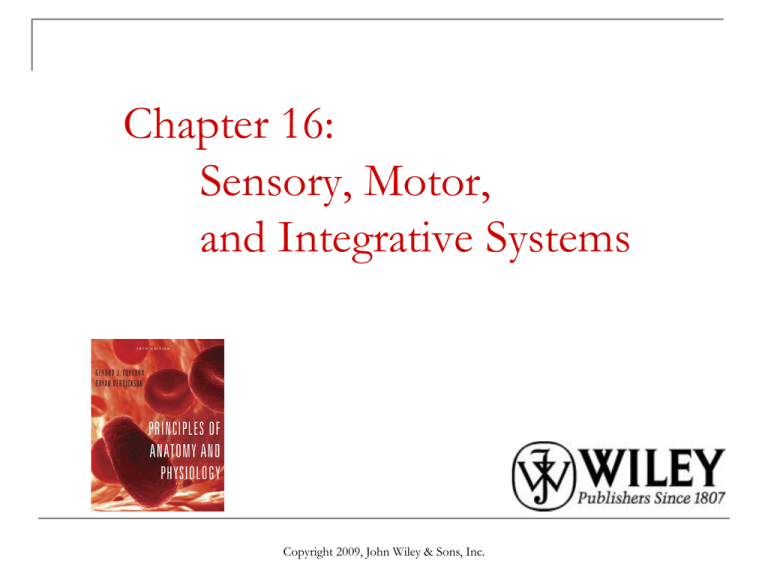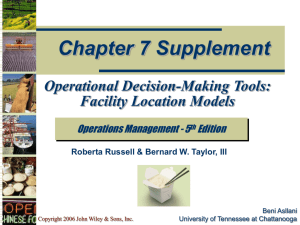
Chapter 16:
Sensory, Motor,
and Integrative Systems
Copyright 2009, John Wiley & Sons, Inc.
Sensation
Conscious and subconscious awareness of
changes in the external or internal
environment.
Components of sensation: Stimulation of the
sensory receptor → transduction of the
stimulus → generation of nerve impulses →
integration of sensory input.
Copyright 2009, John Wiley & Sons, Inc.
Classification of Sensory Receptors
General senses: somatic and visceral.
Somatic- tactile, thermal, pain and
proprioceptive sensations.
Visceral- provide information about conditions
within internal organs.
Special senses- smell, taste, vision, hearing
and equilibrium or balance.
Copyright 2009, John Wiley & Sons, Inc.
Types of Sensory Receptors
Free nerve endings: pain and
thermoreceptors.
Encapsulated nerve endings: pacinian
corpuscles.
Separate cells: hair cells, photoreceptors and
gustatory receptor cells.
Copyright 2009, John Wiley & Sons, Inc.
Generator Potential and Receptor
Potential
Generator potential is produced by free nerve
endings, encapsulated nerve endings, and
olfactory receptors. When it reaches a
threshold, it triggers one or more nerve
impulses in the axon of a first-order sensory
neuron.
Receptor potential triggers the release of
neurotransmitter → postsynaptic potential →
action potential.
Copyright 2009, John Wiley & Sons, Inc.
Sensory Receptors and their Relationship to First-Order Sensory Neurons
Copyright 2009, John Wiley & Sons, Inc.
Classification of Sensory Receptors
Based on the Location
Exteroceptors
Interoceptors
Proprioceptors
Copyright 2009, John Wiley & Sons, Inc.
Classification of Sensory Receptors
based on the type of Stimulus
Mechanoreceptors
Thermoreceptors
Nociceptors
Photoreceptors
Chemoreceptors
Osmoreceptors
Copyright 2009, John Wiley & Sons, Inc.
Adaptation of Sensory Receptors
Rapidly adapting receptors: receptors that
detect pressure, touch and smell.
Slowly adapting receptors: receptors that
detect pain, body position, and chemical
composition of the blood.
Copyright 2009, John Wiley & Sons, Inc.
Somatic Sensations
Sensory receptors in the skin (cutaneous
sensations), muscles, tendons and joints and
in the inner ear.
Uneven distribution of receptors.
Four modalities: tactile, thermal, pain and
proprioceptive.
Copyright 2009, John Wiley & Sons, Inc.
Sensory Receptors in the Skin
Copyright 2009, John Wiley & Sons, Inc.
Tactile Sensations
Include touch, pressure, vibration, itch and
tickle.
Tactile receptors in the skin are Meissner
corpuscles, hair root plexuses, Merkel discs,
Ruffini corpuscles, pacinian corpuscles, and
free nerve endings.
Copyright 2009, John Wiley & Sons, Inc.
Meissner Corpuscles or Corpuscles of
Touch
Egg-shaped mass of dendrites enclosed by a
capsule of connective tissue.
Rapidly adapting receptors.
Found in the dermal papillae of hairless skin
such as in the fingertips, hands, eyelids, tip of
the tongue, lips, nipples, soles, clitoris, and
tip of the penis.
Copyright 2009, John Wiley & Sons, Inc.
Hair Root Plexuses
Rapidly adapting touch receptors found in the
hairy skin.
Free nerve endings wrapped around hair
follicles.
Detect movements on the skin surface that
disturb hairs.
Copyright 2009, John Wiley & Sons, Inc.
Merkel Discs or Tactile Discs
Also known as type I cutaneous
mechanoreceptors.
Slowly adapting touch receptors.
Saucer-shaped, flattened free nerve endings.
Found in the fingertips, hands, lips, and
external genitalia.
Copyright 2009, John Wiley & Sons, Inc.
Ruffini Corpuscles
Also called as type II cutaneous
mechanoreceptors.
Elongated, encapsulated receptors.
Located deep in the dermis and in ligaments
and tendons.
Found in the hands, and soles.
Copyright 2009, John Wiley & Sons, Inc.
Pacinian or Lamellated Corpuscles
Large oval structure composed of a
multilayered connective tissue capsule that
encloses a dendrite.
Fast adapting receptors.
Found around joints, tendons, and muscles;
in the periosteum, mammary glands, external
genitalia, pancreas and urinary bladder.
Copyright 2009, John Wiley & Sons, Inc.
Thermal Sensations
Thermoreceptors are free nerve endings.
Two distinct thermal sensations:
cold receptorswarm receptors-
Copyright 2009, John Wiley & Sons, Inc.
Pain Sensations
Protective.
Sensory receptors are nociceptors.
Free nerve endings.
Two types of pain: fast and slow.
Fast pain: acute, sharp or pricking pain.
Slow pain: chronic, burning, aching or
throbbing pain.
Copyright 2009, John Wiley & Sons, Inc.
Referred Pain
Pain is felt in or just deep to the skin that
overlies the stimulated organ or in a surface
area far from the stimulated organ.
Copyright 2009, John Wiley & Sons, Inc.
Distribution of Referred Pain
Copyright 2009, John Wiley & Sons, Inc.
Proprioceptive Sensations
Receptors are called proprioceptors.
Slow adaptation.
Weight discrimination.
Three types: muscle spindles, tendon organs
and joint kinesthetic receptors.
Copyright 2009, John Wiley & Sons, Inc.
Muscle Spindles
Interspersed among most skeletal muscle
fibers and aligned parallel to them.
Measure muscle stretching.
Consists of intrafusal muscle fibersspecialized muscle fibers with sensory nerve
endings and motor neurons called gamma
motor neurons.
Extrafusal muscle fibers- surrounding muscle
fibers supplied by alpha motor neurons.
Copyright 2009, John Wiley & Sons, Inc.
A Muscle Spindle and a Tendon
Organ
Copyright 2009, John Wiley & Sons, Inc.
Tendon Organs
Located at the junction of a tendon and a
muscle.
Protect tendons and their associated muscles
from damage due to excessive tension.
Consists of a thin capsule of connective
tissue that encloses a few tendon fascicles.
Copyright 2009, John Wiley & Sons, Inc.
Joint Kinesthetic Receptors
Found within or around the articular capsules
of synovial joints.
Free nerve endings and Ruffini corpuscles in
the capsules of joints respond to pressure.
Pacinian corpuscles respond to acceleration
and deceleration of joints during movement.
Copyright 2009, John Wiley & Sons, Inc.
Somatic Sensory Pathways
First-order neuron(somatic receptor to the
brain stem/spinal cord)
→ second order neuron(brain stem/spinal cord
too the thalamus; decussate)
→ third-order neuron(thalamus to the primary
somatosensory area of the cortex).
Copyright 2009, John Wiley & Sons, Inc.
Major Somatic Sensory Pathways
The posterior column-medial lemniscus
pathway.
The anterolateral (spinothalamic) pathway.
The trigeminothalamic pathway.
The anterior and posterior spinocerebellar
pathway.
Copyright 2009, John Wiley & Sons, Inc.
The Posterior Column-Medial
Lemniscus Pathway
Conveys nerve
impulses for touch,
pressure, vibration
and conscious
proprioception from
the limbs, trunk, neck,
and posterior head to
the cerebral cortex.
Copyright 2009, John Wiley & Sons, Inc.
The Anterolateral (spinothalamic)
pathway
Conveys nerve
impulses for pain,
cold, warmth, itch,
and tickle from the
limbs, trunk, neck,
and posterior head to
the cerebral cortex.
Copyright 2009, John Wiley & Sons, Inc.
Trigeminothalamic Pathway
Conveys nerve
impulses for most
somatic sensations
from the face, nasal
cavity, oral cavity and
teeth to the cerebral
cortex.
Copyright 2009, John Wiley & Sons, Inc.
Mapping of the Primary
Somatosensory Area
Mapping of the
postcentral gyrus.
Size of the cortical
region representing a
body part depends on
the sensory impulses
received from that
part.
Copyright 2009, John Wiley & Sons, Inc.
Somatic Motor Pathways
Upper motor neurons → lower motor neurons
→ skeletal muscles.
Neural circuits involving basal ganglia and
cerebellum regulate activity of the upper
motor neurons.
Copyright 2009, John Wiley & Sons, Inc.
Organization of the Upper Motor
Neuron Pathways
Direct motor pathway- originates in the
cerebral cortex.
Corticospinal pathway: to the limbs and trunk.
Corticobulbar pathway: to the head.
Indirect motor pathway- originates in the
brain stem.
Copyright 2009, John Wiley & Sons, Inc.
Mapping of the Motor Areas
Located in the
precentral gyrus of
the frontal lobe.
More cortical area is
devoted to those
muscles involved in
skilled, complex or
delicate movements.
Copyright 2009, John Wiley & Sons, Inc.
The Corticospinal Pathways
Copyright 2009, John Wiley & Sons, Inc.
The Corticobulbar Pathway
Copyright 2009, John Wiley & Sons, Inc.
Indirect or Extrapyramidal Pathways
Originate in the brain stem. Include:
Rubrospinal tract
Tectospinal tract
Vestibulospinal tract
Reticulospinal tract
Copyright 2009, John Wiley & Sons, Inc.
Modulation of Movement from the
Cerebellum
The cerebellum coordinates and
smoothes contractions of skeletal
muscles during skilled movements and
helps maintain posture and balance.
Copyright 2009, John Wiley & Sons, Inc.
Motor areas of
cerebral cortex
Sagittal
plane
Corrective
feedback
Thalamus
Motor centers in
brainstem
Cortex of
cerebellum
4
1
3
Pons
Pontine nuclei
2
Direct pathways
Sensory signals from
proprioceptors in muscles
and joints, vestibular
apparatus, and eyes
Sagittal section through brain and spinal cord
Indirect pathways
Signals to lower
motor neurons
Integrative Functions of the Cerebrum
Wakefulness and sleepLearning and memory-
Copyright 2009, John Wiley & Sons, Inc.
The role of Reticular Activating
System (RAS) in Awakening
Consists of neurons
whose axons project
from the reticular
formation through the
thalamus to the
cerebral cortex.
Increased activity of
the RAS causes
awakening from sleep
(arousal).
Copyright 2009, John Wiley & Sons, Inc.
Sleep
A state of altered consciousness.
Two components: non-rapid eye movement
(NREM) sleep and rapid eye movement
(REM) sleep.
NREM sleep consists of four stages:
Stage 1Stage 2Stage 3Stage 4Copyright 2009, John Wiley & Sons, Inc.
Learning and Memory
Learning is the ability to acquire new
information or skills through instruction or
experience.
Memory is the process by which information
acquired through learning is stored and
retrieved.
Copyright 2009, John Wiley & Sons, Inc.
Memory Types
Immediate memory- recall for a few seconds.
Short-term memory- temporary ability to
recall.
Long-term memory- more permanent.
Memory consolidation.
Copyright 2009, John Wiley & Sons, Inc.
End of Chapter 16
Copyright 2009 John Wiley & Sons, Inc.
All rights reserved. Reproduction or translation of this
work beyond that permitted in section 117 of the 1976
United States Copyright Act without express
permission of the copyright owner is unlawful.
Request for further information should be addressed to
the Permission Department, John Wiley & Sons, Inc.
The purchaser may make back-up copies for his/her
own use only and not for distribution or resale. The
Publishers assumes no responsibility for errors,
omissions, or damages caused by the use of theses
programs or from the use of the information herein.
Copyright 2009, John Wiley & Sons, Inc.






